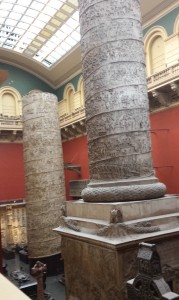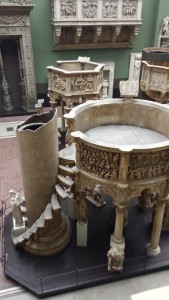One of my favourite short stories is ‘The Real Thing’ by Henry James, a tale about an artist and his models that is also about surface and depth,  appearance and reality. Authenticity.
appearance and reality. Authenticity.
I thought about it recently when visiting one of the places I like to go when in SW7 – the Cast Courts in the Victoria & Albert Museum. The two huge, and hugely popular, double height galleries were built to contain plaster copies of masterworks of European post-classical sculpture and architecture. Given that they include a cast of the entire Portico of the 12th century Cathedral of Santiago de Compostela ( which may have determined the width of Gallery 46a ) and Trajan’s Column, albeit cut in half ( which is likely to have determined its height ) these are very big indeed.
When I first happened across the Courts, some years ago, I was perplexed. Surely that was Trajan’s Column, which I’d often seen in Rome. And Michelangelo’s David, well, I’d seen that in Florence. So what were they doing in South Ken? A closer look and especially a look from the galleried landing above, revealed them to be copies or fakes. Glorious fakes, commissioned specifically by the V & A in the  nineteenth century, for the purpose of bringing the best in European art and architecture to the public in London. You can see the wooden infilled floor of the cast of the stone pulpit by Giovanni Pisano formerly found in Pisa Cathedral ( see right ) and dated to the first decade of the fourteenth century. The cast was made in 1865, from the pieces of the original, which had been dispersed through the Cathedral and some of it destroyed, when another pulpit replaced it.
nineteenth century, for the purpose of bringing the best in European art and architecture to the public in London. You can see the wooden infilled floor of the cast of the stone pulpit by Giovanni Pisano formerly found in Pisa Cathedral ( see right ) and dated to the first decade of the fourteenth century. The cast was made in 1865, from the pieces of the original, which had been dispersed through the Cathedral and some of it destroyed, when another pulpit replaced it.
Indeed, the plaster copies are often preserved rather better than those originals which have survived, battered as they have been by wind, weather and modern pollution. The bas reliefs on the plaster Trajan’s column show him, clearly and cleanly, thumping seven bells out of the Dacians ( in the first century A.D. ) far more distinctly than the original in Trajan’s Forum does now, which is near one of the biggest traffic junctions in Rome. ( Given the confluence of the ancient Vias Sacra, Flaminia and Nomentana, plus the Clivus Argentarius it was probably just as busy when the Column was erected, just without fumes from the internal combustion engine. ) The Column is not the only example of the copy surviving rather better than the original.
In 1873, when the Courts first opened, most people couldn’t afford European travel ( indeed, until the coming of the railways, most folk didn’t travel very far at all ), so the glories of the continental Middle Ages and the Renaissance were to be found only as illustrations and, if you were really forward looking, photographs, in books. In addition, students of art, sculpture and architecture needed not only to study such items for purposes of learning technique, but also to place the British traditions in a wider European context. So the Cast Courts were built. Today the Courts are one of the most visited areas of the V & A, in part because Londoners like me have their favourites and in part because students still  come there to draw and study as students have always done. There were a number present when I visited the other day (see left).
come there to draw and study as students have always done. There were a number present when I visited the other day (see left).
The twentieth century saw the fashion for plaster casts wane, especially after the 1970s when foreign travel became cheaper and more usual. In the ’80s many museums, in the UK and on the continent, closed their cast courts and many casts were destroyed, condemned as inauthentic or unreal, even though they preserved what had been lost. Fortunately the V & A, the museum which can lay claim to starting it all, retained theirs. And they have become authentic of themselves, they are genuine copies, aged by the patina of time. They may not have the essence of the thing they copy, the creative idea and its execution, but they too are beautiful and real, just not the real thing.
Entry to the Victoria & Albert Museum is free. It opens every day from 10.00 a.m. until 17.45 p.m. and late on Fridays. You can learn more about the Cast Courts and the V & A’s ongoing renovation project of the courts and their contents on the V & A web-site.
If you enjoyed reading this article you might also enjoy Undiscovered Leighton House Museum
For more about Giovanni Pisano check out Artsy


 RSS – Posts
RSS – Posts